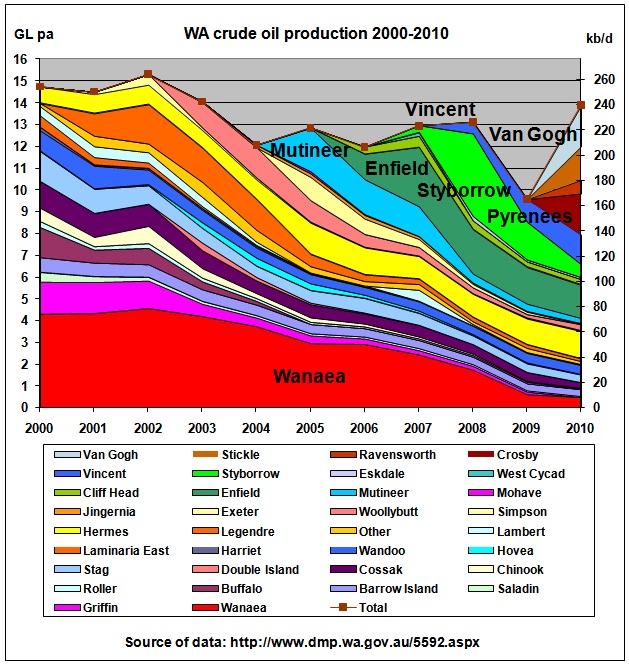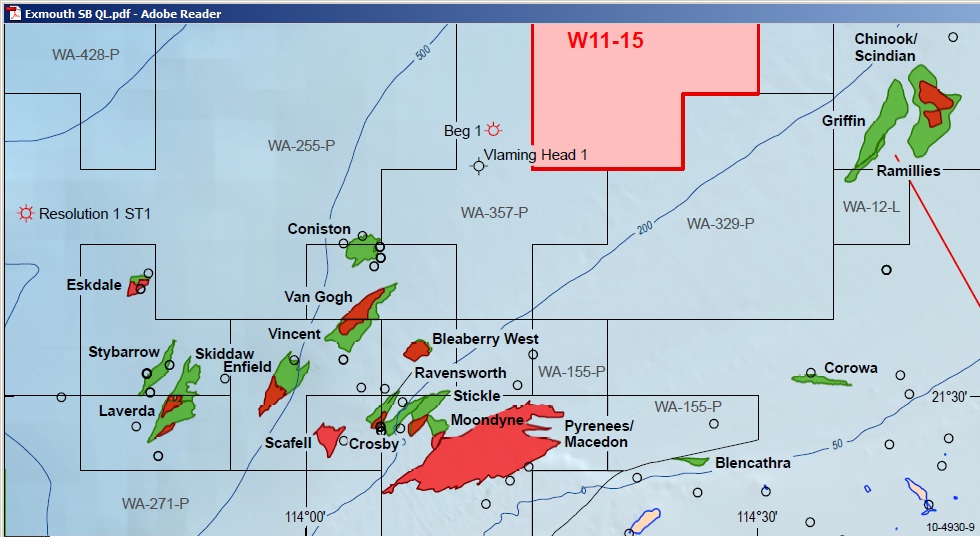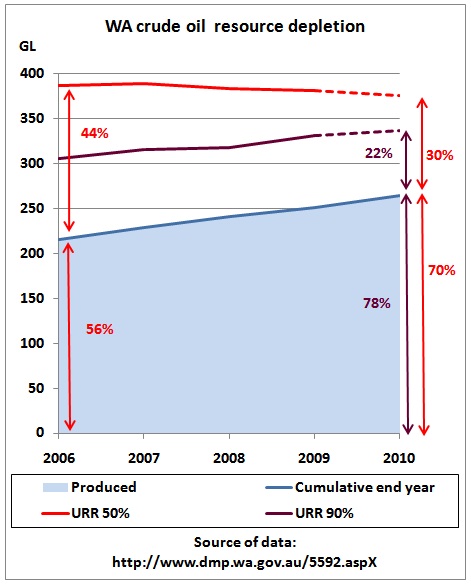According to statistics published by the WA government in April 2011, WA’s crude oil resources including contingencies are depleted by around 75% at end 2010 up from 63% at end 2006. The annual depletion rate is therefore around 3% pa. Crude oil production in 2010 has increased from new fields (Van Gogh, Pyrenees) but the reserve/production ratios in some of these new fields are only 4-5 years. Fields which started in 2004-2008 (Mutineer, Enfield, Styborrow, Vincent) have already peaked and are in decline.
 http://www.dmp.wa.gov.au/documents/000363.jemma.williams.pdf
http://www.dmp.wa.gov.au/documents/000363.jemma.williams.pdf
A quick calculation from the above tables 1 and 2a:
Cumulative Production end 2010: 265 GL
P 50 resources end 2009: 130 GL
Production 2010: 14 GL
Appr. resources end 2010: 116 GL
Depletion at 50% probability = 265 / ( 265 + 116 ) = 70%
Repeating the calculation for P90
Depletion at 90% probability = 265 / ( 265 + 81 – 14 ) = 80%
A more detailed calculation is shown in this graph using resource depletion trends in the years 2006 – 2009
Data from PWA publications: http://www.dmp.wa.gov.au/5592.aspX
P 50 resources have been declining slightly and P90 resources increasing. This means the ultimate recoverable resources (URR) will be somewhere between the 50% and 90% probabilities. Assuming that these trends have continued over 2010 we get depletion levels between 70% and 78%, the average not much different from the quick calculation above. In 2006, the P50 depletion level was only 56%, so there was an increase of 14% to 70% in just 4 years.
Here are the production profiles by field:
 All data are from: http://www.dmp.wa.gov.au/5592.aspx
All data are from: http://www.dmp.wa.gov.au/5592.aspx
We see that pre-2004 fields have declined to a mere 25% of their peak in 2002 in just 8 years. New fields between 2004 and 2008 already peaked in 2008:
which caused a steep drop in total WA production. In 2010, new fields have come on-stream in the Pyrenees group (Stickle, Ravensworth, Crosby).
 http://www.ret.gov.au/Documents/par2011/release-areas/carnarvon/documents/exmouth-sb/Geology%20Exmouth%20Sb.pdf
http://www.ret.gov.au/Documents/par2011/release-areas/carnarvon/documents/exmouth-sb/Geology%20Exmouth%20Sb.pdf
In PWA September 2008, Stickle had P50 reserves of 5.565 GL. With a 2010 production rate of 1.5 GL the reserve/production ratio would only be 5.6/1.5=3.7 years. For Crosby the R/P ratio would be 9.2/1.9=4.8 years. Unfortunately, PWA no longer publishes reserves/resources by field and Ravensworth was not included in PWA Sep 2008. But with estimated recoverable reserves of 80-120 million barrels and a scheduled processing rate of the Pyrenees FPSO of 96 kb/d (5.4 GL pa) we would get 120 mb / 96 kb/d x 365 days = 3.4 years.
Conclusion: Barring new substantial discoveries, WA’s crude oil has entered its last quarter. As extraction rates in new fields are very high (offshore environment) depletion levels will increase by between 3-4% pa on current trends to reach around 85% – 90% by 2015. This will dramatically worsen Australia’s net oil import balance. Given that global crude oil exports have already peaked in 2005 there is a major oil import crisis ahead. Neither banks – who are still financing new tollway projects like the M2 widening in Sydney – nor the general public have been properly informed about these facts.

